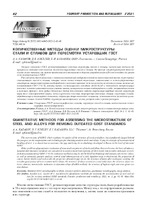Количественные методы оценки микроструктуры стали и сплавов для пересмотра устаревших ГОСТ

Date
2021Publisher
Another Title
Quantitative methods for assessing the microstructure of steel and alloys for revising outdated gost standards
Bibliographic entry
Казаков, А. А. Количественные методы оценки микроструктуры стали и сплавов для пересмотра устаревших ГОСТ = Quantitative methods for assessing the microstructure of steel and alloys for revising outdated gost standards / А. А. Казаков, Д. В. Киселев, Е. И. Казакова // Литье и металлургия. – 2021. – № 2. – С. 42-48.
Abstract
Текущее состояние ГОСТ, регламентирующих качество структуры сталей и сплавов, значительно отстало от прогресса в составах и технологиях получения современных сталей и сплавов. На примере микроструктурной полосчатости стали показано, как можно преодолеть это отставание и довести разработанную в России методику до уровня межгосударственного ГОСТ. Рассмотрены другие решенные с помощью анализатора изображений задачи количественной оценки структурных составляющих сталей и сплавов, которые могут стать основой отраслевых, национальных и межгосударственных стандартов: микроструктурная неоднородность листового проката; неметаллические включения в стали, включая автоматизацию ГОСТ 1778-70, методы оценки с использованием методики ASTM E1245 и статистики экстремальных значений, а также автоматического анализа частиц; центральная осевая неоднородность сляба; ликвационная полоса в листовом прокате; доля грубых бейнитных блоков для описания свойств современных трубных сталей; структура швов после многопроходной сварки; металлургическое качество жаропрочных никелевых сплавов; структура сплавов, обработанных в полутвердом состоянии; структура доэвтектических силуминов; неметаллические включения в алюминиевых сплавах (метод PoDFA); структура высокопрочного чугуна; распределение зерен по размерам.
Abstract in another language
The current state of GOST, which regulates the quality of the structure of steels and alloys, has significantly lagged behind the progress in the compositions and technologies for obtaining modern steels and alloys. Using the example of microstructural banding of steel, it is shown how to overcome this gap and bring the methodology developed in Russia to the level of interstate GOST. Other problems of quantitative evaluation of structural components of steels and alloys that can become the basis of industry, national and interstate standards are considered: microstructural heterogeneity of sheet metal; non-metallic inclusions in steel, including automation of GOST 1778-70, evaluation methods using the ASTM E1245 methodology and statistics of extreme values, as well as automatic particle analysis; central axial inhomogeneity of a slab; liquation strip in sheet metal; the proportion of coarse bainite blocks used to describe the properties of modern pipe steels; the structure of joints after multi-pass welding; the metallurgical quality of heat-resistant nickel alloys; the structure of alloys treated in a semi-solid state; the structure of pre-eutectic silumins; non-metallic inclusions in aluminum alloys (PoDFA method); the structure of high-strength cast iron; grain size distribution.
View/
Collections
- № 2[17]
